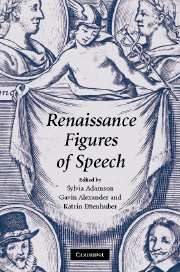Book contents
- Frontmatter
- Dedication
- Contents
- List of illustrations
- List of contributors
- Preface
- Note on spelling and references
- Introduction: the figures in Renaissance theory and practice
- Chapter 1
- Chapter 2
- Chapter 3
- Chapter 4
- Chapter 5
- Chapter 6
- Chapter 7
- Chapter 8
- Chapter 9
- Chapter 10
- Chapter 11
- Chapter 12
- CHAPTER 12 Metalepsis: the boundaries of metaphor
- Chapter 13
- Notes
- Suggestions for further reading
- Index
CHAPTER 12 - Metalepsis: the boundaries of metaphor
Published online by Cambridge University Press: 05 February 2014
- Frontmatter
- Dedication
- Contents
- List of illustrations
- List of contributors
- Preface
- Note on spelling and references
- Introduction: the figures in Renaissance theory and practice
- Chapter 1
- Chapter 2
- Chapter 3
- Chapter 4
- Chapter 5
- Chapter 6
- Chapter 7
- Chapter 8
- Chapter 9
- Chapter 10
- Chapter 11
- Chapter 12
- CHAPTER 12 Metalepsis: the boundaries of metaphor
- Chapter 13
- Notes
- Suggestions for further reading
- Index
Summary
To morrow, and to morrow, and to morrow,
Creepes in this petty pace from day to day,
To the last Syllable of Recorded time:
And all our yesterdayes, have lighted Fooles
The way to dusty death.
Macbeth's reaction to his wife's death and his meditation on time and mortality are characteristic of later Shakespeare in combining epigrammatic grandeur with extreme figurative complexity. The verse is readily remembered but not easy to explain. This sense of linguistic difficulty is not counterproductive, however; one of the features that makes these lines memorable is that it is not possible to catch the sense straightaway, so that it remains mysterious and complex in the same way that the idea Macbeth is expressing is mysterious and complex. His mind is caught at the moment of the most intense effort to explain and understand what his life has been like and how it is going to end, yet it cannot complete its thought or comprehend its own sense. His meaning, like his premonition of death, is haunted by an apprehension of incompleteness.
A quick reflection on the make-up of the sentence shows that it is the figurative sequence, rather than the syntax or diction, that creates a sense of complexity. None of the words individually is difficult or philosophical. Macbeth's sentence presents instead a concatenation of figures which pile quickly on top of each other. His speech refers overtly to the mathematical reckoning of time, measured in terms of speed (‘this petty pace’).
- Type
- Chapter
- Information
- Renaissance Figures of Speech , pp. 217 - 234Publisher: Cambridge University PressPrint publication year: 2007
- 4
- Cited by

